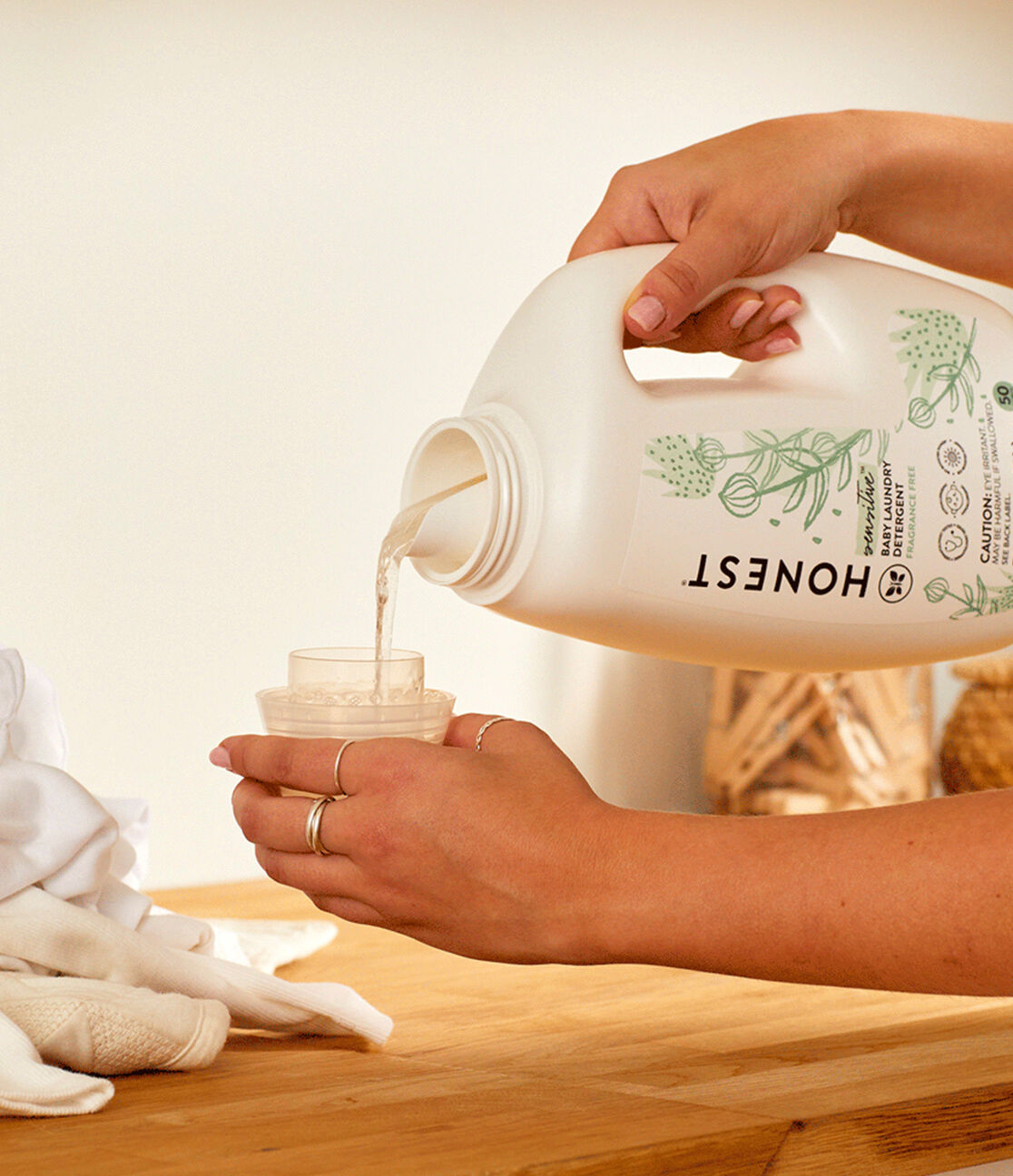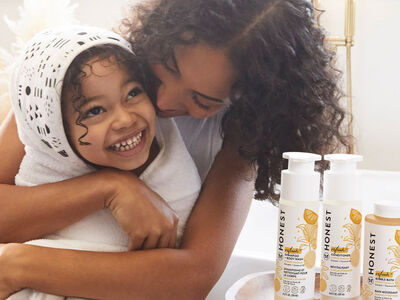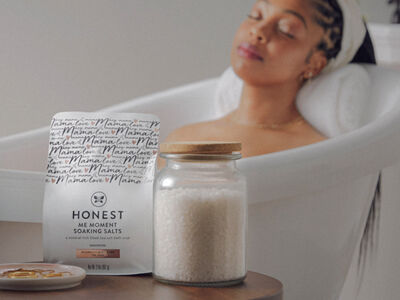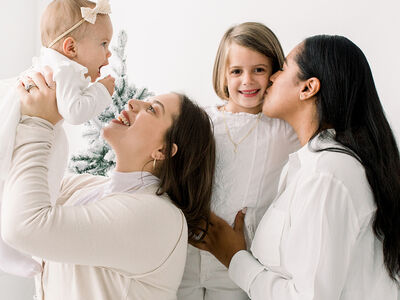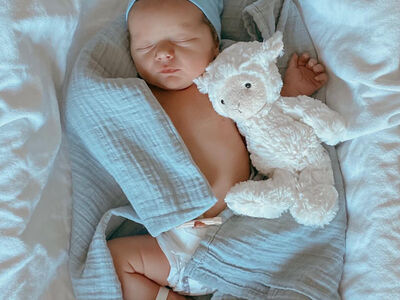When babies are born, one of the most unexpected challenges for new parents is washing baby clothes. For one thing, there are so many tiny items! It’s like the washing machine or the dryer just eats them, they’re so tiny. They go in to be washed and might make it to the dryer, but at some point, they’re never seen again.
Additionally, no one warns parents about the sheer amount of laundry that piles up for babies. There’s no shortage of accidents that occur, which means changing clothes for the little one may happen multiple times per day. Multiple changes means mountains of laundry.
And finally––perhaps most importantly––babies have sensitive skin. Parents struggle with knowing how to wash newborn clothes so that their baby’s skin isn’t bothered. A hypoallergenic baby detergent is a must for this purpose. However, there are other ways to protect their skin. Keep reading for our best tips on washing your baby’s clothes safely.
Hand Washing Your Baby Clothes
Step 1: Clean Your Hands
The first step is to clean your hands to make sure you don’t expose the baby’s clothes to any germs. Make sure to wash your hands with an antibacterial soap or hand washing liquid. To be extra safe, use a disinfecting hand sanitizer as well.
Step 2: Set the Water Temperature
Every fabric has a set water level that it can withstand. Too hot, and the fabric and color can be damaged. Read the labels of your baby’s clothes to understand the manufacturer’s instructions about the fabric requirements. Set the water temperature accordingly; it shouldn’t be so hot or so cold that it hurts your hands. Fill a bucket or tub with this water, or fill the kitchen sink.
Step 3: Soak the Clothes
Dirty clothes, especially those with food or organic waste on them, are an ideal place for bacteria to grow. To make sure you kill as much of the bacteria as possible, soak the baby clothes in hot water before you wash. Just make sure the water is only as hot as the fabric material allows for. This will help soften any leftover residue that’s been left behind.
Step 4: Choose a Detergent
Choosing a detergent for your baby’s clothes is an important decision. The laundering agent will come in contact with your baby’s skin. Remember that your baby’s skin is not as tough as yours; it hasn’t had as much time in the outside world to fully adjust.
To ensure you don’t irritate your baby’s skin, opt for a fragrance-free, hypoallergenic detergent, preferably with no chemical agents whatsoever. To green your laundry routine, choose a laundry agent that’s designed specifically for baby clothes, if possible. Additionally, look for a detergent that’s considered clean and environmentally friendly.
Step 5: Wash the Clothes
After your baby’s clothing is sufficiently pre-soaked, and you’ve got your hands on your baby laundry detergent of your choice, it’s time to do the actual washing of the baby’s clothes. Rub off any stained areas to loosen up the debris. Be gentle with your baby clothes as they’re often made of very soft materials. Rinse after washing baby’s clothes.
Step 6: After-Soak
When your baby’s clothes are washed and rinsed, it’s time for an after-soak. Soak your baby clothes in warm water (not hot), for a few minutes and then wring them out. Make sure there is little to no detergent residue left in the clothes.
Step 7: Dry the Clothes
Once the clothes are completely clean, it’s time to dry them. You can dry them in your dryer machine. However, it’s even better to dry baby clothes in the sun as sunlight is a natural way of killing off any leftover bacteria.
If you don’t have access to a lot of sunlight, dry your baby’s clothes in a hot, sterile room. Be sure they are dried thoroughly, because if not properly dried, it can give rise to fungal growth. Not to mention, putting a baby in damp clothing may increase risks of fungal infections.
Machine Washing Your Baby’s Clothes
Machine washing baby clothes isn’t all that different from hand washing them.
Step 1: Empty Out the Machine
Always empty out the washing machine, first and foremost. Make sure there are no other clothes in it, because it’s better to wash baby clothes separately. Mixing the two can expose each to the other’s germs.
However, sometimes it can be too much to wash baby clothes and other clothes separately. In that case, wash all your clothes with a baby-friendly detergent. Either way, make sure your machine is clean and there’s no debris from previous washes.
Step 2: Pre-Soak & Wash
As with hand-washing, it’s best to pre-soak your baby clothes before machine washing. Soak the clothes as long as necessary to loosen stains and debris.
Step 3: Rinse Twice
When it comes to rinsing, make sure you run the rinse cycle twice. This is to ensure that all germs, dirt, debris, as well as any leftover laundry detergent, is fully removed. For the first cycle, rinse with laundry soap; for the second cycle, rinse with just water.
Step 3: Dry the Clothes
Follow the same drying instructions given for handwashing!
Disinfecting Your Baby’s Clothes
Sometimes, only washing a baby’s clothes is not enough. You have to disinfect them as well. Follow the steps below to safely and effectively disinfect your baby’s clothes when needed.
Step 1: Identify Stains
Identify the areas with stains. This is important because most stains on a baby’s clothes are protein-based or organic in nature. The biggest contributor to this is milk stains, which can be an ideal breeding ground for bacteria. Identify all the areas on the clothing with stains.
Step 2: Scrape Off Bodily Fluids
Speaking on the topic of milk stains, there are other baby body fluids as well. This includes drool, snot, and other organic body fluids. All are full of protein as well as bacteria. If left as is, the bacteria will grow and spread, increasing the chances of the baby getting sick.
Step 3: Remove Stains
Scrape off as much of the stains as possible. Once you’ve scraped off as much as you can, use a scrubbing brush to work out the rest of the debris embedded in the fibers of the clothes. Use a disinfectant laundry detergent for infants while scrubbing; this will kill two birds with one stone.
Step 4: Pre-Soak in Disinfectant
Once you’ve done some target cleaning on the stains, it's time to pre-soak the baby clothes. For this, choose a disinfectant solution that’s suitable for babies, or go with a DIY disinfectant. For the DIY option, make a mixture of a couple of caps of white wine vinegar and a bucket of water. Soak the clothes for 30 minutes before washing. Vinegar is a known antibacterial and antimicrobial agent.
How to Remove Stubborn Stains
Unfortunately, sometimes it’s not as easy as throwing the baby’s clothes in the washer and being done with it. At times, you may have stubborn stains that just won’t go away. Below are some tips on how to deal with them.
Spit / Vomit
There’s no baby in the world that doesn’t spit up frequently! The simplest way of removing spit-up stains from baby clothes for breast-fed babies, is to pre-treat the stain with lemon and then proceed as usual on washing the baby clothes.
However, for formula stains, you’ll need to soak the stained area first. Sprinkle baking soda on the stain, along with some club soda, and then scrub with a brush. Let it soak for 10 minutes, and then wash following the previous wash instructions.
Poop
Some days, you simply can’t prevent an honest diaper blowout. It’s bound to happen every once in a while. Not only that, sometimes the baby even poops or pees right in the middle of changing! In either situation, the end result is the same––poop stains.
To get them out, soak the baby’s clothing in warm water to remove as much of the stain as possible. Then pre-treat the stains with a pre-treating solution of your choice, or just use lemon juice. Let the pre-treatment soak for 10 to 15 minutes before scrubbing the stained area with a brush. Wash as normal.
Baby Oil
Oil massages are so good for a baby’s growth and health. However, they’re not always the best thing for baby clothes! Discolored baby oil stains can prove difficult to remove. To deal with them, try treating the stain with grease-fighting dish soap and scrub with a brush. Then wash as usual.
Learning how to wash baby clothes is a mandatory skill when you become a new parent. It’s a part of the home cleaning checklist! Fortunately, it’s not super complicated. Now, if only there was a way to keep from losing all those baby socks!
Sources:
Alexander, L. (2021, March 23). Washing Baby Clothes (Ultimate How-to Guide). Mom Loves Best. https://momlovesbest.com/wash-baby-clothes
Khan, A. (2020, September 2). Washing Your Baby’s Clothes - How to do it Rightly. FirstCry Parenting. https://parenting.firstcry.com/articles/washing-your-babys-clothes-how-to-do- it-rightly/
We aim to provide you with the most honest and credible information possible. This article was reviewed for accuracy by The Honest Team and was written based on trusted sources that are linked at the bottom of the article.
blog_review_statement